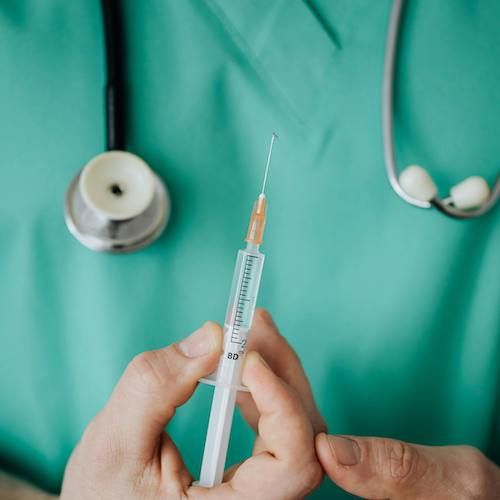News
Article
Vaccine-Related Hematuria in IgA Nephropathy Not Impacted by Infection-Related Hematuria
Author(s):
Gross hematuria due to infection was not associated with the incidence of gross hematuria due to vaccination in patients with IgAN who received COVID-19 mRNA vaccination.
Credit: Pexels

Despite apparent similarities in the pathogenesis of gross hematuria due to infection (n-GH) and vaccination (n-GH) in patients with IgA nephropathy (IgAN), findings from a recent study suggest there is no significant relationship between the two.1
The study, coined by investigators as the first to examine the association between v-GH and n-GH in patients with IgAN, found the presence of n-GH did not show a clear relationship with the incidence of v-GH in a cohort of patients who received coronavirus disease 2019 (COVID-19) mRNA vaccination.1
Characterized by the deposition of IgA in the glomerular mesangium, IgAN is one of the leading causes of glomerulonephritis and renal failure. Although the disease course varies, IgAN generally progresses slowly over time and thus often goes unnoticed until symptoms eventually present, the most common of which is hematuria.2 Given gross hematuria after vaccination presents similarly to gross hematuria after acute mucosal infection, part of the natural history of IgAN, and COVID-19 mRNA vaccination stimulates the production of autoantibodies analogous to the acute response of mucosal immunity from natural infection, v-GH and n-GH may share a clinical background or immune mechanism, but the extent of this relationship is unknown.1
“A number of patients with IgAN have experienced sudden gross hematuria after COVID-19 mRNA vaccination (v-GH),” Takashi Yokoo, MD, PhD, chair of the division of nephrology and hypertension at Jikei University School of Medicine in Japan, and colleagues wrote, describing similarities between gross hematuria after acute mucosal infection and after vaccination.1 “These findings suggest that v-GH and n-GH share a clinical background or immune mechanism, and unraveling these possibilities may provide an opportunity to better understand the pathophysiology of IgAN.”
To determine the effect of n-GH on the development of v-GH in patients with IgAN, investigators enrolled patients > 18 years of age with biopsy-proved IgAN who visited Jikei University Hospital, Jikei Katsushika Medical Center, Jikei Daisan Hospital, or Jikei Kashiwa Hospital between June 1, 2022, and May 31, 2023. Patients who were unvaccinated or had unknown COVID-19 mRNA vaccination status; unknown gross hematuria status or a history of gross hematuria associated with urolithiasis; insufficient data on the urinalysis and blood test results; complications due to other primary glomerular diseases, kidney, or urological cancer; or kidney replacement therapies were excluded.1
Clinical characteristics, including age, sex, height, weight, body mass index, and medical history, including current use of renin-angiotensin-aldosterone system (RAAS) inhibitors, treatment history of corticosteroids or tonsillectomy, and history of gross hematuria, were obtained from patients’ medical records. Investigators also obtained laboratory data from the last outpatient visit before May 31, 2023, and those just before vaccination, including serum creatinine, IgA, C3, urinary protein-to-creatinine ratio, and urinary sediments.1
In total, 459 adult patients with IgAN with available information regarding n-GH who received COVID-19 mRNA vaccinations were enrolled in the study. Among the cohort, 287 (63%) patients did not have a history of n-GH, while 172 (37%) did.1
Investigators observed nonsignificant differences in the prevalence of v-GH among patients with and without n-GH (10.5% vs 7.3%; P = .299). In addition, they pointed out 12 patients had multiple v-GH, including 6 (28.6%) without n-GH and 6 (33.3%) with n-GH, again with no significant difference between the groups.1
Further analyses by age and sex revealed a similar relationship between n-GH and v-GH, with no statistically significant differences observed across any of the subgroups. In an additional subgroup analysis of patients with IgAN who were diagnosed after the initiation of the COVID-19 vaccination campaign, 11 (30.6%) had v-GH in the group without n-GH and 2 (20.0%) had v-GH in the group with n-GH, with no significant difference observed between the groups (P = .7).1
Multivariate analysis accounting for previously reported relevant factors for the incidence of vaccine-induced gross hematuria in patients diagnosed with IgAN, including sex, age, and microscopic hematuria, showed no significant association between n-GH and v-GH. Additionally, the incidence of COVID-19 was not associated with that of v-GH (P = .844) or n-GH (P = .651).1
Investigators mentioned the dependence on patient reports for n-GH episodes and a lack of pre-vaccination data for patients with newly diagnosed IgAN triggered by v-GH as potential limitations to these findings, also citing the lack of generalizability to other races or geographic regions due to most patients in the study being Japanese.1
“Despite some possible similarities in pathogenesis, we failed to demonstrate a clear relationship between v-GH and n-GH, suggesting the involvement of factors specific to each condition,” investigators concluded.1 “To better understand the pathogenesis of IgAN, further studies are warranted to elucidate the various immunological activation pathways that are commonly or differentially involved in the development of gross hematuria due to infection or vaccination.”
References
- Okabe M, Tsuboi N, Hatanaka S, et al. Does COVID-19 vaccination trigger gross hematuria in patients with IgA nephropathy? Clinical Kidney Journal. https://doi.org/10.1093/ckj/sfae160
- National Institute of Diabetes and Digestive and Kidney Diseases. IgA Nephropathy. Kidney Disease. September 2022. Accessed July 8, 2024. https://www.niddk.nih.gov/health-information/kidney-disease/iga-nephropathy
2 Commerce Drive
Cranbury, NJ 08512
All rights reserved.





